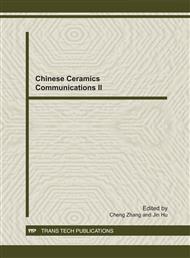p.298
p.302
p.306
p.310
p.314
p.318
p.322
p.326
p.331
Electrical Characteristics and Microstructures of Gd-Doped Bi4Ti3O12 Ceramics
Abstract:
The electrical properties of Gd-doped bismuth titanates Bi4-xGdxTi3O12) prepared by a conventional ceramic technique have been investigated. At applied d.c. field below 200V/mm, the current-voltage curve of Gd-doped sample exhibits a negative differential resistance behavior. The conducting filamentary model has been used to explain the negative differential resistance phenomenon in Gd-doped bismuth titanates. The impedance spectrum of Gd sample indicates that both consist of semiconducting grain and moderately insulating grain boundary regions. XRD, SEM and EPMA analyses reveal crystalline phase characterized by a Bi-layered perovskite structure of Bi4Ti3O12 and the distribution of every element is uniform. Gd-doped sample exhibites randomly oriented and plate-like morphology.
Info:
Periodical:
Pages:
314-317
Citation:
Online since:
November 2011
Authors:
Keywords:
Price:
Сopyright:
© 2012 Trans Tech Publications Ltd. All Rights Reserved
Share:
Citation:


